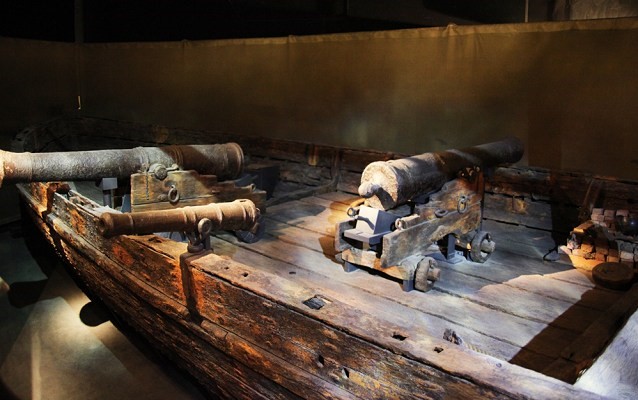Last updated: August 2, 2018
Place
Philadelphia (U.S. Gundelo)

Little more than a rowboat compared with modern vessels, the Philadelphia was one of the hastily built boats constructed in early summer of 1776 at the present town of Whitehall, New York. On September 23, 1776, the fleet took position in the small bay west of Valcour Island, about seven miles south of what is now Plattsburg, New York. The body of water between the island and the mainland was about three quarters of a mile wide. Arnold's fleet formed its line below a bluff on the west of the island and in this position fought the heavier British fleet to a standstill on October 11.
The American fleet was badly damaged in the action and only with considerable luck was Arnold able to elude the enemy and escape southward during the night. During the battle, the Royal Savage, the American flagship, and the Philadelphia had sunk to the bottom on October 11. Only four of Arnold's vessels managed to elude the British pursuit during the next two days.
In 1935, Lorenzo Haggluend identified and salvaged the Philadelphia, remarkably well preserved by the cold water, from the sandy lake bottom near the midchannel of Valcour Bay. After the retrieval of her guns, a twelve-pounder and two nine-pounders, the hull was raised 57 feet to the surface and towed to the beach. While submerged, the vessel sheltered hundreds of other relics including shot, cooking utensils, tools, buttons, buckles and human bones.
In the ensuing years, Haggluend exhibited the vessel at various points on Lake Champlain and the Hudson, prior to establishing a permanent exhibit space at Exeter, New York. In 1961 Haggluend’s will bequeathed the Philadelphia to the Smithsonian Institution. Ever since, tourists trek to the third floor of the Smithsonian's National Museum of American History in Washington, D.C. to view the Philadelphia and virtually all the artifacts recovered with it in 1935.
In recent years the original payroll of the Philadelphia, whose crew was hitherto unknown, was recovered, in some documents at Fort Concho, Texas. The payroll lists the entire 44 men of the crew, including Captain Benjamin Rue from Pennsylvania. More than half of the crew hailed from New Hampshire.
The Philadelphia's hull is 54 feet in length, 15 feet in beam and approximately five feet deep. Construction was almost entirely of oak. The 35-foot tall mast was found intact except for the top portion, and the hull timbers were still in place. Three shot holes, one with a cannon still in it, are visible in the hull. Considering the punishment it took in battle and its long years underwater, the Philadelphia is an exceptionally well-preserved survivor of this important Revolutionary War naval battle.
National Historic Landmark Nomination of the Philadelphia (U.S. Gundelo)
National Historic Landmarks (NHLs) are historic places that possess exceptional value in commemorating or illustrating the history of the United States. The National Park Service’s National Historic Landmarks Program oversees the designation of such sites. There are just over 2,500 National Historic Landmarks. All NHLs are also listed in the National Register of Historic Places.
